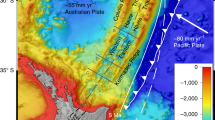Abstract
DISCUSSIONS on the opening of the South Atlantic in terms of major plate tectonic structures such as spreading ridges, transform faults, and so on, have tended to concentrate on the West African segments1–3. Evidence has been presented for regarding the original break in the Gulf of Guinea as an RRR junction, the southward-trending arm becoming the Mid-Atlantic Ridge, the north-east-trending arm (Benue Trough) undergoing a relatively minor phase of opening followed by closing, and the westward arm becoming modified by a series of oblique shears so that movement there became a combination of spreading and transform motion (ref. 1, Fig. 1). An analogous set of movements was proposed for the Red Sea, Dead Sea, Gulf of Suez junction. Later, a large number of other triple junctions was recognised4, including a Georgetown RRR junction to the west which helped to define the course of the Africa/South America split and left the Takutu rift in Guyana as a failed arm filled with Cretaceous deposits.
This is a preview of subscription content, access via your institution
Access options
Subscribe to this journal
Receive 51 print issues and online access
$199.00 per year
only $3.90 per issue
Buy this article
- Purchase on Springer Link
- Instant access to full article PDF
Prices may be subject to local taxes which are calculated during checkout
Similar content being viewed by others
References
Burke, K., Dessauvagie, T. F. J., and Whiteman, A. J., Nature, 233, 51–55 (1971).
Grant, N. K., Bull. geol. Soc. Am., 82, 2295–2298 (1971).
Burke, K., and Whiteman, A. J., in Implications of Continental Drift to the Earth Sciences, II (edit. by Tarling, D. H., and Runcorn, S. K.), 735–755 (Academic, London, 1973).
Burke, K., and Dewey, J. F., J. Geol., 81, 406–433 (1973).
Geotimes, 19, 16–18 (November, 1974).
Zambrano, J. J., and Urien, C. M., in The Geology of Continental Margins (edit. by Burk, C. A., and Drake, C. L.). 463–470 (Sprinper, New York, 1974).
Newton, A. R., Trans. geol. Soc. S. Afr., 76, 145–152 (1973).
Dingle, R. V., and Scrutton, R. A., Bull. geol. Soc. Am., 85, 1467–1474 (1974).
Larsen, R. L., and Ladd, J. W., Nature, 246, 209–212 (1973).
Author information
Authors and Affiliations
Rights and permissions
About this article
Cite this article
NEWTON, A. Was there an Agulhas triple junction?. Nature 260, 767–768 (1976). https://doi.org/10.1038/260767a0
Received:
Accepted:
Published:
Issue Date:
DOI: https://doi.org/10.1038/260767a0
Comments
By submitting a comment you agree to abide by our Terms and Community Guidelines. If you find something abusive or that does not comply with our terms or guidelines please flag it as inappropriate.



